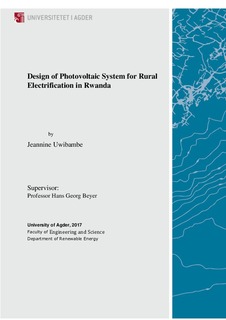| dc.description.abstract | In this century of accelerated development in various domains, some African countries are still facing a challenge of lack of power due to its scarce in some places, where by the main source of power (generation of electricity) is hydro since thermal and fuel are still on a small scale. This problem results in less productivity and economic decline of some countries like Rwanda which is among African countries that are at a very high speed in development, the grid lines from distant places are stack and they are few compared to the need of electricity in all corners of the country, especially in rural areas whereby each household needs power usage instead of using local and traditional means of ironing and lighting at home. This issue can be solved using other alternative sources of Renewable Energy for rural electrification such as Photovoltaic systems. Therefore, this master’s thesis project is mainly focusing on the design of off-grid Photovoltaic systems that include an economic evaluation between the use of an individual solar home system of 200W and a village PV system of 10kW so that the satisfactory of people and the targets of the country can be easily achieved. Under this Master’s thesis work, the first part is focused on the analysis of electricity consumption based on single house owning individual solar home systems taking a case study of one village in Rwanda called Kanazi located in Eastern Province, Bugesera District, Nyamata Sector. This analysis is done through the evaluation of the average primary load profile in consecutive number of hours per day depending on the PV production capacity.
The purpose of this analysis is to obtain the optimum sizing of the PV panel as well as the battery capacity that can be used for providing electricity to households. The second step is to design a village PV system with a big battery and inverter that can generate electricity for the selected village depending on the estimated the average daily load profile for a typical single house in Kanazi village. Finally, both proposed and designed systems will be compared to obtain a system that is more reliable and economical for electricity production. In this project the design and simulation tasks will be performed through the help of Homer software and Excel Software. The information about the average monthly solar radiation on the selected site and the characteristics of PV system components will be provided by different internet websites, PVGIS (Photovoltaic Geographical Information System) for Africa, different books, scientific research papers, journals and the field survey that have been conducted.
Keywords: Rural electrification, Renewable Energy, Off-grid PV Systems, Grid lines, solar home systems, mini-grid systems and Homer software | nb_NO |

